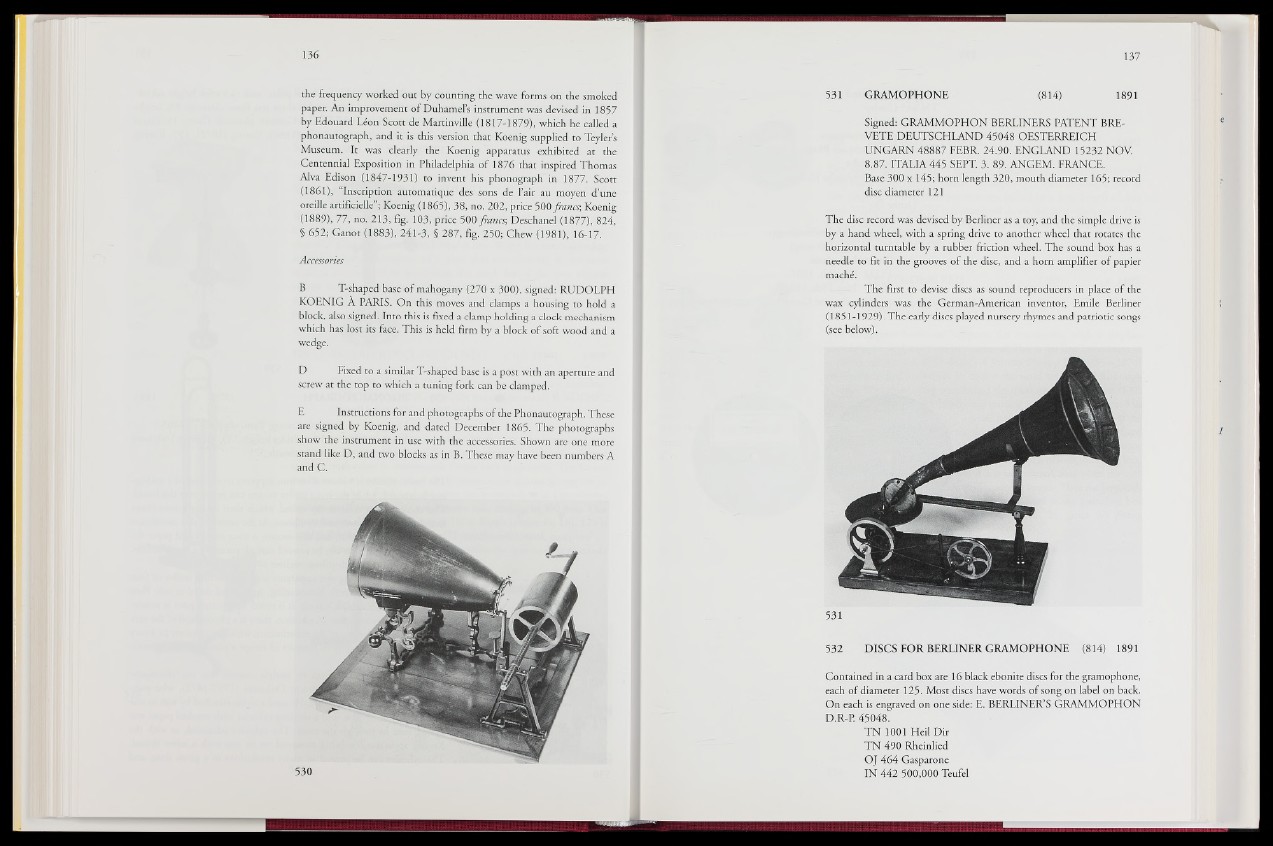
the frequency worked out by counting the wave forms on the smoked
paper. An improvement of Duhamel’s instrument was devised in 1857
by Edouard Léon Scott de Martinville (1817-1879), which he called a
phonautograph, and it is this version that Koenig supplied to Teyler’s
Museum. It was clearly the Koenig apparatus exhibited at the
Centennial Exposition in Philadelphia of 1876 that inspired Thomas
Alva Edison (1847-1931) to invent his phonograph in 1877. Scott
(1861), “Inscription automatique des sons de l’air au moyen d’une
oreille artificielle”; Koenig (1865), 38, no. 202, price 500 francs; Koenig
(1889), 77, no. 213, fig. 103, price 500 francs; Deschanél (1877), 824,
§ 652; Ganot (1883), 241-3, § 287, fig. 250; Chew (1981), 16-17.
Accessories
B T-shaped base of mahogany (270 x 300), signed: RUDOLPH
KOENIG À PARIS. On this moves and clamps a housing to hold a
block, also signed. Into this is fixed a clamp holding a clock mechanism
which has lost its face. This is held firm by a block of soft wood and a
wedge.
D Fixed to a similar T-shaped base is a post with an aperture and
screw at the top to which a tuning fork can be clamped.
E Instructions for and photographs of the Phonautograph. These
are signed by Koenig, and dated December 1865. The photographs
show the instrument in use with the accessories. Shown are one more
stand like D, and two blocks as in B. These may have been numbers A
and G. ■
531 GRAMOPHONE (814) 1891
Signed: GRAMMOPHON BERLINERS PATENT BREVETE
DEUTSCHLAND 45048 OESTERREICH
UNGARN 48887 EEBR. 24.90. ENGLAND 15232 NOV.
8.87. ITALIA 445 SEPT. 3. 89. ANGEM. FRANCE.
Base 300 x |M5; horn length 320, mouth diameter 165; record
disc diameter 121
The disc record was devised by Berliner as a toy, and the simple drive is
by a hand wheel, with a spring drive to another wheel that rotates the
horizontal turntable by a rubber friction wheel. The sound box has a
needle to fit in the grooves of the disc, and a horn amplifier of papier
maché.
The first to devise discs as sound reproducers in place of the
wax cylinders was the German-American inventor, Emile Berliner
(1851-1929). The early discs played nursery rhymes and patriotic songs
(see below).
532 DISCS FOR BERLINER GRAMOPHONE (814) 1891
Contained in a card box are 16 black ebonite discs for the gramophone,
each of diameter 125. Most discs have words of song on label on back.
On each is engraved on one side: E. BERLINER’S GRAMMOPHON
D.R-P. 45048.
TN 1001 Heil Dir
TN 490 Rheinlied
OJ 464 Gasparone
IN 442 500,000 Teufel